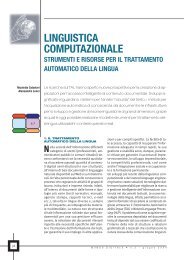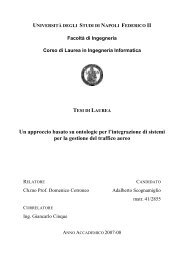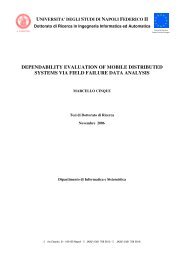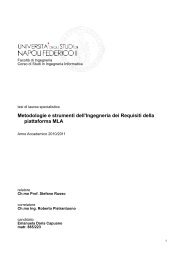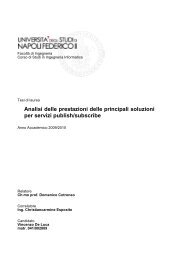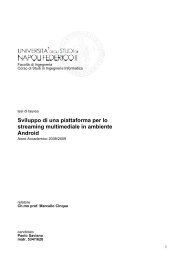Facoltà di Ingegneria Tesi di laurea ANALISI DELLE TECNOLOGIE ...
Facoltà di Ingegneria Tesi di laurea ANALISI DELLE TECNOLOGIE ...
Facoltà di Ingegneria Tesi di laurea ANALISI DELLE TECNOLOGIE ...
You also want an ePaper? Increase the reach of your titles
YUMPU automatically turns print PDFs into web optimized ePapers that Google loves.
co<strong>di</strong>ce “00”, mentre quelle meno privilegiate “11” (il ring 0 può eseguire le istruzioni<br />
privilegiate, il ring 3 non ha alcun privilegio <strong>di</strong> gestire le risorse hardware) [16].<br />
Figura 2.11: sistema <strong>di</strong> privilegio<br />
2.3 Architettura x86 e virtualizzazione<br />
Nonostante significative innovazioni, l’architettura x86 poneva particolari <strong>di</strong>fficoltà<br />
nell’essere virtualizzata, perché richiedeva hypervisor molto complessi e tecniche software<br />
che sovraccaricavano il processore, avendo un impatto negativo in termini <strong>di</strong> prestazioni e<br />
costi. Fino a tempi recenti, l’architettura x86 non rispettava i requisiti <strong>di</strong> Popek e Golberg<br />
(1974), ovvero con<strong>di</strong>zioni sufficienti per l’efficiente virtualizzazione ; secondo i due<br />
informatici americani, un’ambiente virtuale doveva tre proprietà fondamentali:<br />
1) Equivalence / Fidelity<br />
“A program running under the VMM should exhibit a behavior essentially identical to that<br />
demonstrated when running on an equivalent machine <strong>di</strong>rectly”.<br />
2) Resource control / Safety<br />
“The VMM must be in complete control of the virtualized resources”.<br />
29



